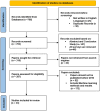Latest Research Trends in Fall Detection and Prevention Using Machine Learning: A Systematic Review
- PMID: 34372371
- PMCID: PMC8347190
- DOI: 10.3390/s21155134
Latest Research Trends in Fall Detection and Prevention Using Machine Learning: A Systematic Review
Abstract
Falls are unusual actions that cause a significant health risk among older people. The growing percentage of people of old age requires urgent development of fall detection and prevention systems. The emerging technology focuses on developing such systems to improve quality of life, especially for the elderly. A fall prevention system tries to predict and reduce the risk of falls. In contrast, a fall detection system observes the fall and generates a help notification to minimize the consequences of falls. A plethora of technical and review papers exist in the literature with a primary focus on fall detection. Similarly, several studies are relatively old, with a focus on wearables only, and use statistical and threshold-based approaches with a high false alarm rate. Therefore, this paper presents the latest research trends in fall detection and prevention systems using Machine Learning (ML) algorithms. It uses recent studies and analyzes datasets, age groups, ML algorithms, sensors, and location. Additionally, it provides a detailed discussion of the current trends of fall detection and prevention systems with possible future directions. This overview can help researchers understand the current systems and propose new methodologies by improving the highlighted issues.
Keywords: fall detection; fall prevention; machine learning; review paper.
Conflict of interest statement
The authors declare no conflict of interest.
Figures













References
-
- Sciubba J.D. Population Aging as a Global Issue. Oxford Research Encyclopedia of International Studies; Oxford, UK: 2020. - DOI
-
- United Nations . World Population Ageing 2020 Highlights: Living Arrangements of Older Persons. United Nations Department of Economic and Social Affairs; NY, USA: 2020. [(accessed on 24 July 2021)]. Available online: https://www.un.org/development/desa/pd/news/world-population-ageing-2020....
Publication types
MeSH terms
Grants and funding
LinkOut - more resources
Full Text Sources
Medical

